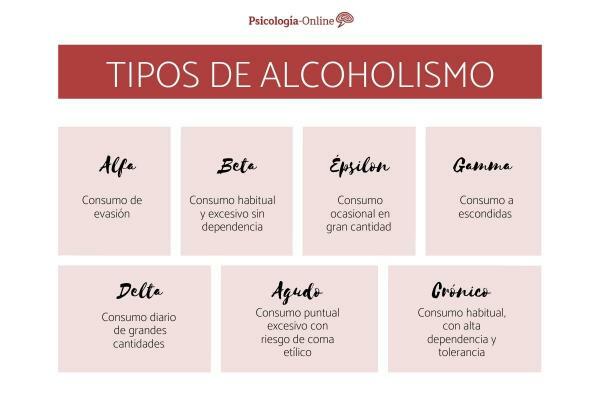
An addiction can be expressed or defined in so many ways that sometimes it is quite difficult to distinguish and, above all, to recognize that there is a problem in us or in someone close to us. Generally we relate addiction only to the consumption of some substance. Such as alcohol, cannabis, opioids, hallucinogens, tobacco, stimulants, inhalants, anxiolytic drugs and others. But starting from the general knowledge that most of us have of addiction and the definition that is shared in the article What is an addiction: definition and why it happens. We will continue referring in Psychology-Online the different types of addictions and their consequences.
In addictions, it is known that people lose control of consumption, and there is often a deterioration in the quality of life due to the negative consequences of addictive behavior. But this excessive, harmful and dependent consumption manifests itself in different areas, some of them are recognized as an object of study by the American Psychiatric Association, proposing for example the
What types of addictions are there? The types of addictions and dependencies are the following:
1. Substance addiction
Substance use addiction is one of the most recognized since this is one of those that publicly can generate greater and frequent obvious damages. Due to physiological symptoms due to intoxication (nystagmus, motor impairment, tachycardia, conjunctival injection, insomnia, hallucinations or illusions and hyperactivity autonomic nervous system) the effects of this addiction develop serious and immediate problems after the start of its use, which is why it is very difficult to cover up.
The effects of poisoning, whether chronic or not, are very difficult to hide or inhibit in the same way its consequences: violence, accidents, physical illnesses, family and social problems, poor job performance, social indiscretions and breach of obligations. Although some of them may be hidden under expected medical expectations, such as prescription opioid abuse. In the following article you will find more information about drugs and their effects according to the WHO.
2. Addiction to people
Addiction to people is generally known as codependency, that is, needs or is dependent on someone else to feel safe and serene. In this type of addiction the emotional states depend on the other person (if she feels good, me too), there is a constant and excessive need to be close and under the control of the other being, each time he needs to share more time with the other, he spends much of the time thinking or looking for the way to be with the other person. These should not be confused specifically with love relationships as a couple, these codependencies can also be directed at family and friends.
3. Social networks addiction
The Social networks addiction It is one of the addictions that recently began to be reflected and better known where people spend most of the day browsing one or more social networks. In these they can be seeing different publications, commenting, writing with other people, uploading photographs, watching videos but all this with an intense anxiety that is not present in the habitual use of these spaces. People addicted to social media feel the need to be connected most of the time of the day, spending long periods of time browsing and getting access to the internet or some device where they can navigate, show breach of their responsibilities for investing time in their networks social, have anxious symptoms when they cannot access the platforms and begin to need more time than they initially used to navigate.
4. Pathological gambling
Another type of addiction is pathological gambling, which is characterized by the need to bet amounts of money growing older to get the desired pleasure. The pathological behavior is exacerbated in moments of restlessness (depression or anxiety). It is no less frequent than the others listed in this article. But, although it is one of the most common, due to its own symptoms, the person with this addiction tends to hide and deny the problem.
5. Internet game addiction
Internet gaming addiction is the third most common addiction after pathological gambling and drug use disorders. substances that are manifested in the Diagnostic and Statistical Manual of Mental Disorders DSM 5 (2013) as a pathology, although Internet gambling disorder still remains a condition that requires further study, it presents symptoms equivalent to a addiction.
This addiction is characterized by a persistent and recurring use of the internet to play games, which are often with other online players and cause clinically significant impairment or discomfort. With this addiction, withdrawal symptoms appear when eliminating Internet games (for example, irritability, anxiety or sadness, but there are no physical signs of withdrawal). Tolerance is also present (such as a need to spend more and more time playing these games).
The addicted person expresses unsuccessful attempts to control participation in Internet games and a loss of interest in hobbies that he had before. The excessive use of games continues despite knowing the associated psychosocial problems that may arise or be exacerbated by participation in these.
Internet games are generally used to avoiding or alleviating negative affect (eg feelings of guilt, anxiety, sadness, helplessness).

One of the most important consequences within addictions and dependencies are the substance / drug-induced mental disorders which are serious and generally temporary syndromes, although they can become persistent and develop as consequence of substance or medication abuse. Some of the mental disorders that can appear as a result of abuse can be the following and should be carefully evaluated in the differential diagnosis by the professional clinical:
- Substance / Medication-Induced Psychotic Disorders.
- Substance / Drug-Induced Bipolar Disorder.
- Substance / Drug-Induced Depressive Disorder.
- Substance / Medication-Induced Anxiety Disorder.
- Substance / Medication-Induced Obsessive-Compulsive Disorder.
- Substance / Drug-Induced Sleep Disorder.
- Substance / drug-induced sexual dysfunction.
- Any neurocognitive substance / drug use disorder.
How do addictions affect? Deterioration from addictions of any kind mentioned above can have serious consequences, such as:
- Deterioration in work or academic performance
- Social indiscretions
- Interpersonal problems
- Breach of responsibilities
- Traffic accidents
- Fighting over uninhibited behavior
- Violations
- High-risk behaviors (for example, having unprotected sex)
- Reckless driving
- Medication or substance overdose
- Putting or losing important relationships with family or friends
- May engage in robbery or prostitution with the aim of acquiring the substances
- Neurocognitive impairments
- Physical illnesses
- Increased risk of HIV infection or some other sexually transmitted condition with used intravenous injections and unprotected sex
These are roughly the most common consequences, however the pattern of consequences will vary with the particular addiction.

Two types of psychological therapy for addictions are explained below:
Psychoanalysis: intervention therapy for addictions
In psychoanalysis, psychic conflict, history, internal difficulties and the symbolization of the subject are observed. Awareness of the disease does not imply recognizing oneself as an addicted person, but rather exploring and articulating in language the internal difficulties that have led the person to consume or expose themselves to certain activities in a way compulsive. The interest of psychoanalysis is that the person is recognized as a subject or as a person who is more than an addict; It is sought that the person is not defined by the inert object that he consumes, but by the meaning it has in his story and his words.
In this psychoanalytic approach, the objective is not for the person to abandon consumption, but to achieve acknowledge your inner conflicts.
Joseph J. Sandler (1986) mentions that when a person claims to be an addict, he would have to question her speech. Consumption abuse is a symptom for psychoanalysis, which will forward through analytical understanding. The symptom here is the desire to consume and it is here that an understanding of the person who suffers it must be formed by offering questions that help him / her understand it:
- What makes you want to consume?
- What moods, emotions, situations stimulate your desire to consume?
The difficulties of these people are manifested by not having the ability to articulate in language the internal difficulties that led them to obsessive consumption. They have difficulties to be aware or realize what they are feeling, as well as to reflect on their internal world.
The development of the structure and functions of the brain are conditioned by the interaction that takes place Between genes and experience, each parenting experience directly affects the way the genes are activated. genes. It should be noted that what the child's brain needs are reciprocal interactions with its primary support network and not massive sensory stimulation.
Behavioral therapy for addictions
In behavioral therapy, three types of intervention techniques derived from different learning models are proposed:
- The exposure techniques to clues derived from classical conditioning
- The programs of skills training o relapse prevention based on the principles of social learning
- The programs of contingency management derived from the principles of operant conditioning
These three approaches should not be understood as exclusive or independent strategies, but rather as complementary techniques that should be integrated into the available treatment programs.
This article is merely informative, in Psychology-Online we do not have the power to make a diagnosis or recommend a treatment. We invite you to go to a psychologist to treat your particular case.


